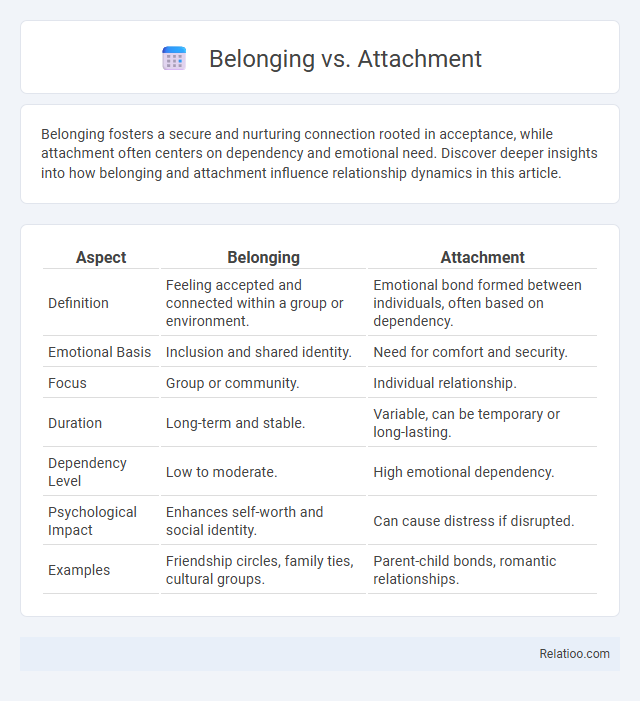Belonging fosters a secure and nurturing connection rooted in acceptance, while attachment often centers on dependency and emotional need. Discover deeper insights into how belonging and attachment influence relationship dynamics in this article.
Table of Comparison
| Aspect | Belonging | Attachment |
|---|---|---|
| Definition | Feeling accepted and connected within a group or environment. | Emotional bond formed between individuals, often based on dependency. |
| Emotional Basis | Inclusion and shared identity. | Need for comfort and security. |
| Focus | Group or community. | Individual relationship. |
| Duration | Long-term and stable. | Variable, can be temporary or long-lasting. |
| Dependency Level | Low to moderate. | High emotional dependency. |
| Psychological Impact | Enhances self-worth and social identity. | Can cause distress if disrupted. |
| Examples | Friendship circles, family ties, cultural groups. | Parent-child bonds, romantic relationships. |
Understanding Belonging: A Core Human Need
Understanding belonging as a core human need involves recognizing its role in emotional well-being and social identity. Unlike attachment, which emphasizes the bond formed primarily in early relationships for safety and security, belonging extends to acceptance within groups and communities, fostering a sense of inclusion and purpose. By cultivating belonging, individuals experience greater motivation, resilience, and overall mental health, highlighting its fundamental importance in human development.
Defining Attachment: Emotional Bonds Explained
Attachment refers to the deep emotional bonds formed between individuals, characterized by trust, security, and a desire for closeness. Unlike belonging, which emphasizes inclusion within a group, attachment centers on the personal, emotional connection that provides comfort and stability. Your emotional well-being often depends on the strength and quality of these attachments, shaping how you relate to others.
Belonging vs Attachment: Key Differences
Belonging refers to a deep sense of acceptance and connection within a group or community, where Your identity aligns naturally with shared values and culture. Attachment, in contrast, is an emotional bond often tied to security and dependence, commonly seen in relationships that fulfill personal needs rather than communal identity. Understanding these key differences helps clarify that belonging encompasses a broader social integration, while attachment centers on personal emotional ties.
Psychological Foundations of Belonging
Belonging is a fundamental human need rooted in psychological theories such as Maslow's hierarchy, emphasizing secure connections within social groups for mental well-being. Attachment theory differentiates early emotional bonds formed in childhood, which influence your capacity to form meaningful relationships and a stable sense of belonging later in life. Understanding the psychological foundations of belonging highlights the importance of secure, consistent, and supportive interactions to foster resilience and identity integration.
The Role of Attachment in Relationships
Attachment plays a critical role in shaping the quality and stability of relationships by influencing emotional bonds and security between individuals. Unlike belonging, which refers to the sense of acceptance within a group or community, attachment centers on the deep, emotional connection formed primarily in close relationships, such as between partners or caregivers and children. Secure attachment fosters trust and empathy, leading to healthier relational dynamics and greater resilience to conflict.
How Belonging Influences Identity Formation
Belonging influences identity formation by providing a sense of acceptance and connection within a group, which helps shape your self-concept and social identity. Unlike attachment, which revolves around emotional bonds primarily in close relationships, belonging encompasses a broader social context that fosters inclusion and shared values. Understanding the distinction between belonging and attachment is essential for recognizing how social environments contribute to your personal growth and identity development.
The Impact of Attachment Styles on Well-being
Attachment styles significantly influence well-being by shaping emotional regulation and relationship quality. Secure attachment correlates with higher self-esteem, better stress management, and overall mental health, whereas insecure attachment styles such as anxious or avoidant are linked to increased risk of anxiety, depression, and lower life satisfaction. Understanding these dynamics is crucial for therapeutic interventions aimed at improving social connections and psychological resilience.
Building Belonging in Communities and Groups
Building belonging in communities and groups fosters a deep sense of connection that transcends simple attachment or surface-level association. Your engagement with others strengthens shared identity and trust, promoting emotional safety and mutual support essential for collective resilience. Prioritizing inclusive practices, open communication, and meaningful participation cultivates authentic belonging that empowers individuals and enhances group cohesion.
Healing Unhealthy Attachments
Healing unhealthy attachments involves distinguishing between belonging, attachment, and true connection to foster emotional well-being. Unhealthy attachments often stem from unmet needs and create dependency, whereas belonging offers a secure sense of acceptance and community that supports personal growth. Prioritizing belonging over attachment encourages healing by cultivating relationships based on mutual trust, safety, and authenticity.
Fostering Genuine Connection: Balancing Belonging and Attachment
Fostering genuine connection requires balancing belonging, attachment, and autonomy to create healthy relationships. Your sense of belonging provides security and acceptance within a community, while attachment influences emotional bonds and dependency levels. Cultivating authentic belonging without over-reliance on attachment promotes resilience and long-term relational well-being.

Infographic: Belonging vs Attachment
 relatioo.com
relatioo.com